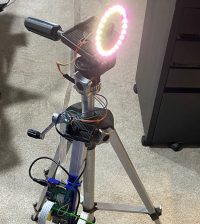- How to Adjust X and Y Axis Scale in Arduino Serial Plotter (No Extra Software Needed)Posted 7 months ago
- Elettronici Entusiasti: Inspiring Makers at Maker Faire Rome 2024Posted 7 months ago
- makeITcircular 2024 content launched – Part of Maker Faire Rome 2024Posted 9 months ago
- Application For Maker Faire Rome 2024: Deadline June 20thPosted 11 months ago
- Building a 3D Digital Clock with ArduinoPosted 1 year ago
- Creating a controller for Minecraft with realistic body movements using ArduinoPosted 1 year ago
- Snowflake with ArduinoPosted 1 year ago
- Holographic Christmas TreePosted 1 year ago
- Segstick: Build Your Own Self-Balancing Vehicle in Just 2 Days with ArduinoPosted 1 year ago
- ZSWatch: An Open-Source Smartwatch Project Based on the Zephyr Operating SystemPosted 1 year ago
Crickit, the Python-oriented RPi HAT add-on for robotics!

The Adafruit Crickit (Creative Robotics & Interactive Construction Kit) HAT is designed for controlling motors, servos, or solenoids using Python 3. The board is limiting to powering 5V devices and requires a 5V power supply.
The Crickit HAT is a way to make robotics and interactive art projects with your Pi. Plug the Crickit HAT onto your Pi using the standard 2×20 GPIO connector and start controlling motors, servos or solenoids. You also get eight signal pins with analog inputs or PWM outputs, capacitive touch sensors, a NeoPixel driver and 3W amplified speaker. It complements and extends your Pi, doing all the things a Pi can’t do, so you can still use all the goodies on the Pi like video, camera, internet and Bluetooth…but now you have a robotics and mechatronics playground as well!
Specifications listed for the Adafruit Crickit HAT include:
- 4x analog or digital servo control, with precision 16-bit timers
- 2x bi-directional brushed DC motor control, 1 Amp current-limited each, with 8-bit PWM speed control (or one stepper)
- 4x high-current “Darlington” 500mA drive outputs with kick-back diode protection — for solenoids, relays, large LEDs, or one uni-polar stepper
- 4x capacitive touch input sensors with alligator pads
- 8x signal pins, which can be used as digital in/out or analog inputs
- 1x NeoPixel driver with 5V level shifter connected to the seesaw chip (not the Pi), so you won’t be giving up pin 18. It can drive over 100 pixels.
- 1x Class D, 4-8 ohm speaker, 3W-max audio amplifier connected to the I2S pins on the Pi for high-quality digital audio — even works on Zeros
- 1x micro-USB to serial converter port for updating seesaw with the drag-n-drop bootloader, or plugging into a computer; it can also act as a USB converter for logging into the console and running command lines on the Pi.















